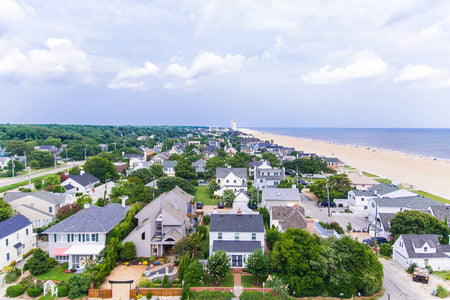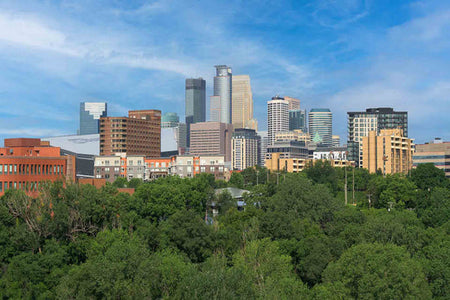- Pollen season in Illinois lasts from early spring to late fall, with the worst months for allergies typically falling between April and October, depending on your location.
- Common allergens include tree pollen (oak, maple, birch), grass pollen (bluegrass, rye, fescue), and weed pollen (ragweed).
- Take proactive steps like starting medications early, such as Allermi nasal spray, to stay ahead of allergy season, along with monitoring pollen counts, using air purifiers, and adjusting your habits to reduce exposure.
Illinois has a diverse landscape, with both urban areas like Chicago and wide rural spaces. This mix creates a variety of allergens that may affect the health of residents in different ways.
For example, city dwellers in Chicago may face higher levels of air pollution and dust, which can worsen respiratory issues, while those in rural areas might experience more pollen from grasses, trees, and weeds.
With such a wide range of allergens, the allergy season in Illinois can vary depending on where you live. In this article, we will discuss the details of pollen season, including when it starts and the worst months for allergies.
We'll also cover when pollen season typically ends, list common allergens in Illinois, and share helpful tips so you can prepare and manage your symptoms effectively.
When is the Pollen Season in Illinois?
Pollen season in Illinois varies slightly between regions due to differences in climate and vegetation but typically starts in late winter or early spring and can last until late fall.
In northern Illinois, including Chicago, the allergy season starts later in the year. Tree pollen peaks in March and April, with urban parks like Lincoln Park contributing to significant pollen levels. Grass pollen becomes more prominent from May to July, while weed pollen, particularly ragweed, takes over from August to October.
In central Illinois, the warmer weather causes pollen season to start earlier, typically in late February. Tree pollen peaks in March and April, with common allergens including hickory, oak, and ash. Grass pollen becomes prominent from May to early July, followed by weed pollen, which dominates from late July through October.
In southern Illinois, the season starts the earliest, sometimes in February, and can last until November. Tree pollen begins first, followed by grass pollen in spring and summer, and weed pollen lasting into the fall months. The Shawnee National Forest, for example, is rich in trees, grasses, and weeds, which contribute to high pollen levels during allergy season. This means allergy sufferers in the area may experience symptoms for much of the year.
What are the Worst Months for Allergies in Illinois?
The worst months for allergies in Illinois typically align with the peaks of tree, grass, and weed pollen seasons. These periods are the most challenging for allergy sufferers, as the pollen levels from various plants reach their highest concentrations.
- Spring (April and May). Trees such as oak, maple, and birch release large amounts of pollen during this period, which causes symptoms like sneezing, itchy eyes, and congestion [*]. Maple trees, in particular, produce bright yellow pollen that is often visible to the naked eye, as they coat surfaces like cars and sidewalks. This visual sign serves as a reminder to allergy sufferers to take precautions.
- Summer (June and July). Grass pollen peaks during these months, which can trigger allergies for many people sensitive to grasses like bluegrass, rye, and fescue. Bluegrass and rye are commonly found in lawns, while fescue is prevalent in both lawns and agricultural settings.
- Fall (August to October). Ragweed pollen, one of the most potent allergens, peaks during this time and can cause severe symptoms until the first frost, usually in October. Its lightweight nature allows it to travel long distances, with ragweed pollen found up to 400 miles out to sea and 2 miles in the air. Even if you don't live near ragweed, you can still be affected [*].
Allergy severity may vary each year based on weather conditions, with warm, windy days often exacerbating symptoms.
When Does Pollen Season End in Illinois?
Pollen season in Illinois typically ends with the first hard frost, which varies by region. In northern Illinois, this usually happens in late October, while central Illinois may see frost by mid to late October. Southern Illinois, with its milder climate, may not experience a hard frost until early to mid-November.
The arrival of frost kills off most pollen-producing plants, thereby bringing the pollen season to an end. However, weather variations can extend the season in warmer years.
Common Allergens in Illinois
It’s important to be aware of the wide variety of triggers that can affect residents throughout the year. If you suffer from allergies, stay mindful of the allergens in your area and adjust your precautions accordingly.
- Oak
- Maple
- Birch
- Elm
- Hickory
- Kentucky bluegrass
- Fescue
- Ryegrass
- Ragweed
- Pigweed
- Lamb’s quarters
- Mold
How to Prepare for Seasonal Allergies in Illinois
Preparing for seasonal allergies in Illinois doesn’t have to be overwhelming. Small adjustments can lead to big relief. Start with these tips:
- Track pollen levels. Monitoring daily pollen levels is important because it helps you anticipate high pollen days and take proactive steps to reduce your exposure. Limit outdoor activities when levels are high, especially in the morning when pollen is most abundant.
- Keep windows closed. Close all windows in your home, including those in bedrooms, living rooms, and kitchens, as well as the windows in your car. This prevents pollen from entering and settling indoors.
- Use air purifiers. While not every home necessarily needs a HEPA air purifier, they can be especially helpful for people with allergies or asthma. HEPA filters are effective at capturing tiny particles like pollen, dust, and pet dander to improve air quality in areas where allergens are a concern.
- Shower after being outdoors. Rinse off pollen by showering and changing clothes immediately after spending time outdoors, especially in areas with high concentrations of allergens, such as parks, gardens, or grassy fields.
- Take preventative medication. Start using antihistamines a few weeks before your symptoms begin. For targeted relief, try a combination nasal spray like Allermi, which addresses multiple symptoms in one spray, with no systemic side effects. For long-term relief, allergy shots may also be considered.
- Wear protective gear. Masks help block pollen from being inhaled, while sunglasses protect the eyes from direct exposure to airborne pollen, especially on windy days when pollen is more likely to be dispersed.
- Clean regularly. Vacuuming with a HEPA filter traps pollen and prevents it from becoming airborne. Wash bedding once a week to remove allergens, or more often (every 3-4 days) if you're particularly sensitive, especially during peak pollen seasons.
The Bottom Line
Managing seasonal allergies in Illinois can be a challenge due to the wide variety of allergens that vary by region and season. The right preparations will allow you to enjoy the changing seasons.
The key to managing allergies is staying informed, planning ahead, and adjusting your habits to fit the season. Using targeted treatments, such as a combination nasal spray, can also help manage multiple symptoms.
References:
- Hassan Mansouritorghabeh, P., Mojtaba Sankian, P., & Abdolreza Varasteh, P. (2019). The Most Common Allergenic Tree Pollen Grains in the Middle East: A Narrative Review. Iranian Journal of Medical Sciences, 44(2), 87. https://pmc.ncbi.nlm.nih.gov/articles/PMC6423439/
- AAFA Community Services. (n.d.). Ragweed Woes: How to Win Against One of Pollen’s Worst Offenders. Asthma and Allergy Foundation of America. https://community.aafa.org/blog/how-to-win-against-ragweed-pollen-allergy









